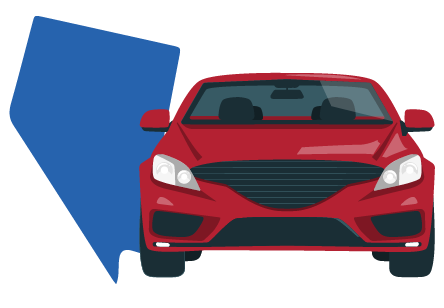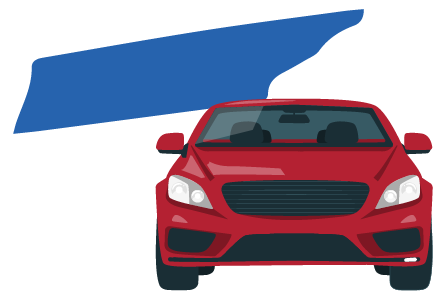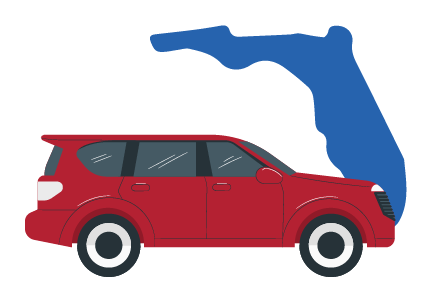In Nevada, you must carry a valid car insurance policy while driving. That means you must have at least the minimum liability coverage required by the state. This auto insurance coverage is designed to help pay for injuries and damages to other people if you’re found at-fault in an accident. You should be able to show that insurance to a police officer if they ask.
In addition to meeting Nevada auto insurance requirements, you should also check with your leasing company or vehicle’s lienholder to see if they have any extra insurance requirements. Those might include comprehensive and collision coverage.
Reviewing Nevada’s minimum insurance requirements, and the optional insurance coverages that can give you additional protection, is a good idea. That way, you’re protected and in compliance with Nevada car insurance requirements.
Minimum mandatory auto insurance in Nevada
To drive legally in Nevada, you must carry at least the minimum liability insurance to protect yourself financially in the event of an at-fault accident. According to the Nevada Division of Insurance, as of July 1, 2018, state laws require all automobile liability policies to meet the “25/50/20” standard. The breakdown of minimum liability coverage for Nevada is listed below.
- $25,000 bodily injury liability coverage for one person in any one accident.
- $50,000 bodily injury liability coverage for two or more people in any one accident.
- $20,000 for property damage liability coverage per accident.
These minimum requirements are to cover the costs of injuries and property damage to others in an accident you cause. While these meet the legal requirements, you should consider whether higher policy limits would be better depending on your situation.
Is Minimum Auto Insurance in Nevada adequate coverage?
Nevada’s minimum auto insurance requirements, $25,000 bodily injury coverage per person, $50,000 per accident, and $20,000 property damage, are the same as those of many other states but may not be enough in the event of a serious accident.
Medical bills from an insurance claim can add up quickly if multiple people are hurt. That $20,000 property damage coverage won’t cover the cost of a new car. If your coverage isn’t sufficient, you could be held personally responsible for the remaining damages. That means your personal savings, income, or other assets could be exposed to lawsuits.
Increasing your policy’s liability limits with your insurance provider is a good idea. Many insurance agents advise going with a 50/100/50 policy. You may want to consider even higher limits if you have significant assets.
Liability insurance won’t cover your medical bills or damage to your car. For more comprehensive coverage, you’ll want to talk to your insurance carrier about medical payments, uninsured/underinsured motorist coverage, collision coverage, or comprehensive insurance.
Optional Car Insurance Options in Nevada
In Nevada, where liability insurance is the only auto insurance coverage required by law, you can get your hands on several optional insurance products that provide extra protection for vehicles and occupants. These additional coverages go beyond what the state minimum car insurance requirements demand.
- Collision Coverage: Pays for repairs or replacement of your vehicle if it’s damaged in a collision with another car or object, regardless of fault.
- Comprehensive Coverage: Covers non-collision damages like theft, vandalism, fire, flood, falling objects, and animal impacts. This is important for protecting your vehicle from environmental and unexpected hazards.
- Uninsured/Underinsured Motorist Coverage (UM/UIM): Protects you and your passengers if you’re injured in an accident caused by an uninsured or underinsured driver.
- Medical Payments Coverage (Medpay): Pays for medical expenses for you or your passengers after an accident, regardless of fault. It also covers medical care for bodily injury for pedestrians hit by a vehicle.
- Personal Injury Protection (PIP): Also known as “no-fault insurance,” PIP covers medical bills and lost wages for you and your passengers, regardless of fault. It’s broader than Medpay in some cases.
- Gap Insurance: This coverage fills the gap between your vehicle’s actual cash value and the balance of your auto loan or lease if it is declared a total loss.
- Roadside Assistance: Covers common roadside emergencies like flat tires, battery failures, lockouts, and towing needs.
These optional coverages allow Nevada drivers to customize their auto insurance policies to fit their financial situation and risk tolerance for more protection in case of an accident or unexpected vehicle incident.
Penalties for Driving Without Insurance in Nevada
Nevada requires all drivers to have continuous liability auto insurance coverage. To enforce this insurance coverage requirement, the state has a tiered penalty system that gets more severe the longer the lapse in coverage and the number of prior offenses in the last 5 years.
Penalties for not having coverage can include fines, reinstatement fees, SR-22 insurance, and even driver’s license suspension. The penalties for not having an active auto insurance policy are listed below.
First Offense
- Reinstatement Fee: $250 (regardless of lapse duration)
- Fines:
- $0 for 1-30 days
- $250 for 31-90 days
- $500 for 91-180 days
- $1,000 for 181+ days
- SR-22 Required: For lapses over 90 days
- Total Cost: $250 to $1,250
Second Offense in 5 years
- Reinstatement Fee: $500
- Fines:
- $0 for 1-30 days
- $500 for 31-180 days
- $1,000 for 181+ days
- SR-22 Required: For lapses over 90 days
- Total Cost: $500 to $1,500
Third Offense in 5 years
- Reinstatement Fee: $750
- Fines:
- $0 for 1-30 days
- $500-$1,000 for longer lapses
- SR-22 Required: Regardless of lapse duration
- Driver’s License Suspension: 30 days minimum
- Total Cost: $750 to $1,750
Additional Notes:
- Driver’s License Reinstatement includes additional fees: $75 reinstatement fee, license reissuance fees, and possible retesting.
- There is no grace period for a lapse in insurance coverage. You will be fined if you are without auto insurance for one day.
- These administrative penalties are separate from any fines or citations law enforcement gives.
Not having car insurance in Nevada can cost you big time. Make sure to pay your insurance premiums on time to ensure continuous coverage.
SR-22 Insurance for High-Risk Drivers in Nevada
If you are a high-risk driver in Nevada, you must have SR-22 insurance. SR-22 insurance is a Certificate of Financial Responsibility that your insurance company must file with the Department of Motor Vehicles (DMV). This certificate proves you have the state minimum liability coverage. If your SR-22 lapses at any time the DMV will be notified and your license will be suspended.
SR-22 insurance is required for people convicted of a DUI, multiple serious traffic violations or accidents, or multiple license suspensions. Uninsured motorists found to be at-fault drivers in accidents may need to get an SR-22 before legally driving again in Nevada.
Why is it essential to follow Nevada’s Car Insurance Requirements?
Having the right Nevada auto insurance is crucial, not just to comply with Nevada insurance law but to protect yourself and your assets. Carrying the required minimum coverage can leave you with a big bill out of pocket if you get into a big accident. To minimize that risk, increase your liability limits and look into other coverage options to fill in the gaps.
At Insurance Navy, we make it easy to compare auto insurance quotes side by side so you can find the best auto insurance rates and the coverage that fits you. Contact an insurance agent today or get a free quote online.
Frequently Asked Questions
What are the minimum liability insurance limits in Nevada?
You must carry liability insurance with minimum limits of $25,000 per person, $50,000 total per accident, and $20,000 property damage per accident (25/50/20). Liability coverage pays for injuries or damages you cause to others in an accident.
Does Nevada require coverage types other than liability?
No. Nevada only requires liability insurance to financially protect others if you’re at fault in an accident. Collision, comprehensive, and roadside assistance are optional.
Is uninsured/underinsured motorist (UM/UIM) coverage mandatory?
No. Nevada insurance companies must offer UM/UIM coverage with limits equal to the minimum liability (25/50/20), but you can decline it. If you decline uninsured motorist coverage, you must do so in writing.
Do I need to carry proof of insurance in the vehicle, or can I show it digitally?
Both. Nevada allows you to present either a printed insurance card or electronic evidence of insurance on your smartphone or mobile device during traffic stops or vehicle registration.
How does the DMV know if my Nevada insurance lapses?
The Nevada DMV uses the NVLIVE electronic verification system, which checks throughout the year to confirm that every registered vehicle has liability coverage and detects lapses.
What are the penalties for driving without insurance in Nevada?
If your insurance lapses the first time, you’ll pay a minimum $250 reinstatement fee, and your vehicle registration will be suspended until valid coverage is reinstated. Subsequent or prolonged lapses will result in higher fines, fees, and longer registration suspensions.
When would I need to file an SR-22?
An SR-22 insurance certificate is required after a conviction for serious traffic offenses (DUI or reckless driving) or if you’ve had an insurance lapse of 91 days or more on your driving record. Once required, you must maintain the SR-22 filing for three consecutive years.
How soon do new state residents need to get Nevada auto insurance?
New residents have 30 days from establishing residency to get a Nevada auto insurance policy and register their vehicle with the DMV. Failure to meet this deadline will result in fines or penalties.





